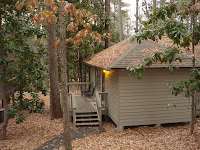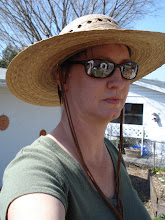It started innocently enough in March of 2006 when we bought 4 daylilies from BADS, the
Bay Area Daylily Society at
Greenfest. Shortly after that, we found that the Central Florida Hemerocallis Society was having a daylily sale at
Leu Gardens in Orlando. We came home with about 40 varieties. About a month after that, we drove up to Brooksville to
Johnson's Daylily and Bamboo Farm, and the owners, Jeff and Linda Johnson invited us to a picnic the next weekend. Little did we know at the time, it was the annual end-of-season picnic for BADS, and we met most of the club members and became members ourselves. Well, I did anyway. Jay mostly sat outside in the shade under the cypress trees in the daylily garden.
 |
| Jeff and "Lori Goldston" |
Over the next year Jay came to a few meetings with me, and we started to become friends with a few of the members. When the club invited us to go to "Mecca," the annual pilgrimage to the East Coast of Florida where a majority of the daylily hybridizer "royalty" resides, we went along. We saw some gorgeous commercial gardens as well as beautiful private daylily home gardens. Now Jay is the President of the club and I giggle about that almost every time I think about it. We are currently gearing up for the club's 18th annual show and sale.
 |
| Watermill Gardens, 2007 |
We've had our ups and downs with bloom success, and have learned a lot about what daylilies like (chicken, mule and cow poop, sun and water) and don't like (tree roots). This has been our best bloom year yet. We have about 110 named varieties in our yard, and are foster-parenting about 50 plants left over from the BADS sale and show last year.
 |
| Swirling Spider |
Most of our named cultivars are in 3 raised beds that Jay built, and the rest are in pots by the house. We have about 50 unnamed seedlings (affectionately called The Bastards) and two or three unidentified (lost tag) plants as well.
 |
| Two beds and a coop |
Friends who dabble in hybridizing have shared their seedlings with us. It's always fun to see one of these bloom for the first time - knowing that you're seeing a flower that nobody else in the world has seen. The science behind hybridizing is really fascinating, but we haven't started trying to do it ourselves. It requires much more record-keeping than either of us has time or inclination to do. We like that it's fun and not work. I'm afraid that hybridizing would make it more of a work project.
Some of our favorites have come all the way from Merrymeetings Daylilies in New Durham, New Hampshire. They were hybridized and grown by a dear man named Les Turner, and have given us some of our most beautiful plants this year, now that they are well established and happy in our warmer climate. Here are a few of the outstanding Merrymeeting Seedlings this year. We are probably going to enter them in the show in the Seedling category.
 |
| MMS Seedling #2 |
We've shared many of these seedlings with neighbors, family and friends, and all of them have produced beautiful faces for people to look at in the spring mornings.
This yellow spider is so fragrant you can smell it when you are 8-10 feet away from it. It looks a lot like two other cultivars named Boney Maroney and Lemon Madeline, but is actually bigger than they are, and has more 'diamond dusting' on it. (This is daylily geek-speak for being all sparkly on the petals.)
 |
MMS Seedling #5
|
Every morning, about 6:30, Jay and I head out to the garden in our "yard shoes" with our cameras in tow to see what is blooming for the first time that day and to ooh and aah about how pretty everything is. We probably have 100 pictures of the same place in our garden, but each one is slightly different depending on what has bloomed that day. Jay walks around with a bowl and picks off all the dead flowers from the day before while the chickens putter around and chat to one another. When it's time to go in, all the spent flowers go into the coop with the girls, and they munch on them for their morning snack. This is the only thing that gets me up on my own, excited about morning. The rest of the year I'm highly resistant to the concept of daybreak.
We're both so grateful for the beauty and friendship these little plants have brought to us. Some of our closest friends are 'daylily people.' The plants also teach us to be appreciative of individual beauty, and to be tough and patient. As pretty as they are, they are really resilient little guys, and will perform their little hearts out if given the chance. Next weekend is the show. It always hurts my heart a little bit to cut the flowers to take in to be 'judged.' As if one is more beautiful or more deserving than another. Mother Nature knows what she's doing, and it seems arrogant to me to put one flower up as a paragon of beauty, when, like people, each one is probably doing the very best it can do under the circumstances it's been placed in.




































